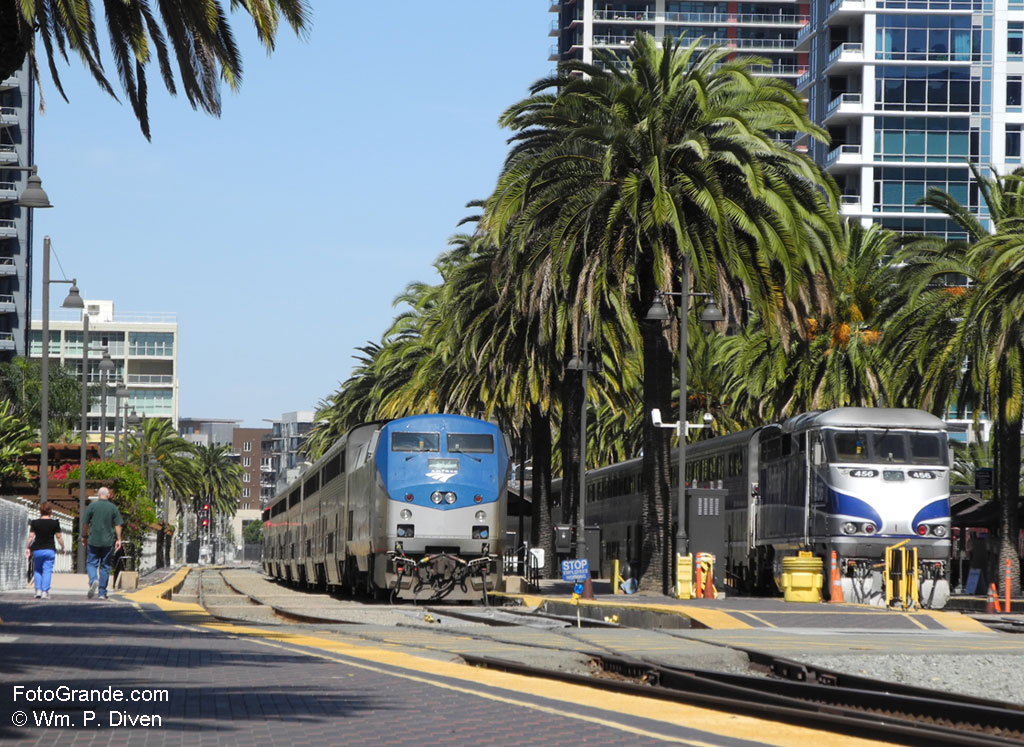When fire turned Albuquerque’s railroad station into smoking rubble on a January night, the blame variously fell to homeless folk lighting a fire to stay warm or trouble in the electrical system of the 91-year-old building. Call it another hard-luck episode in the history of Amtrak in New Mexico.
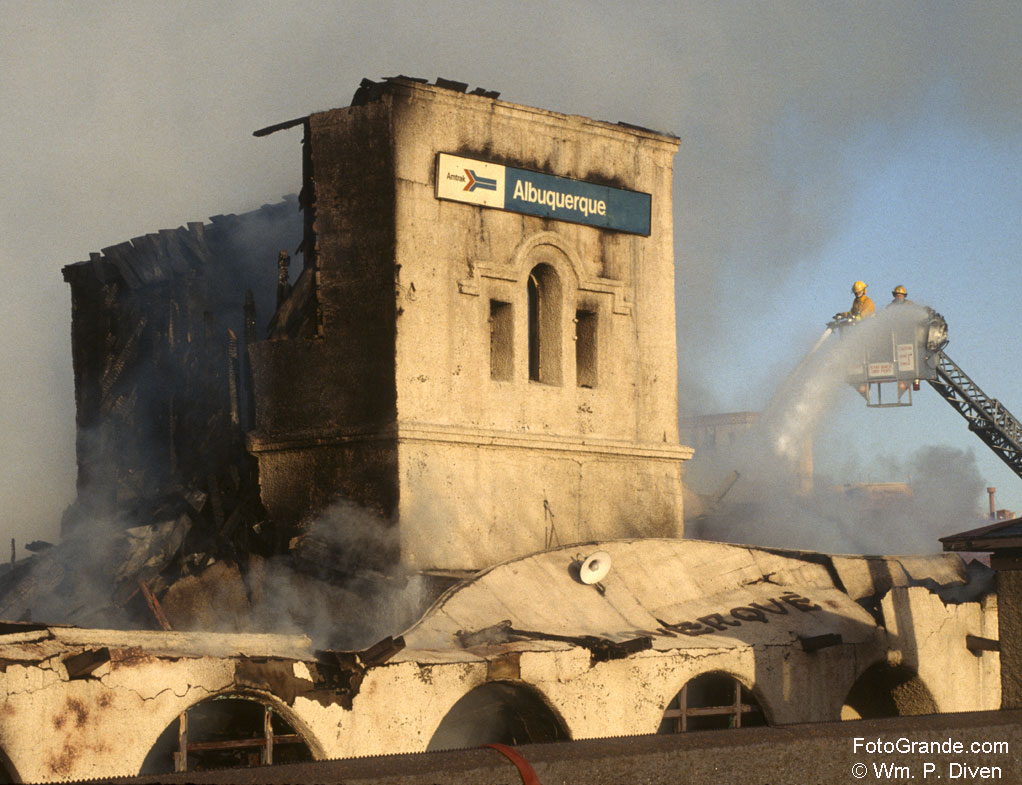
Albuquerque firefighters hose down the smoldering wreckage of the Amtrak station. January 4, 1993. © William P. Diven (Click to enlarge)
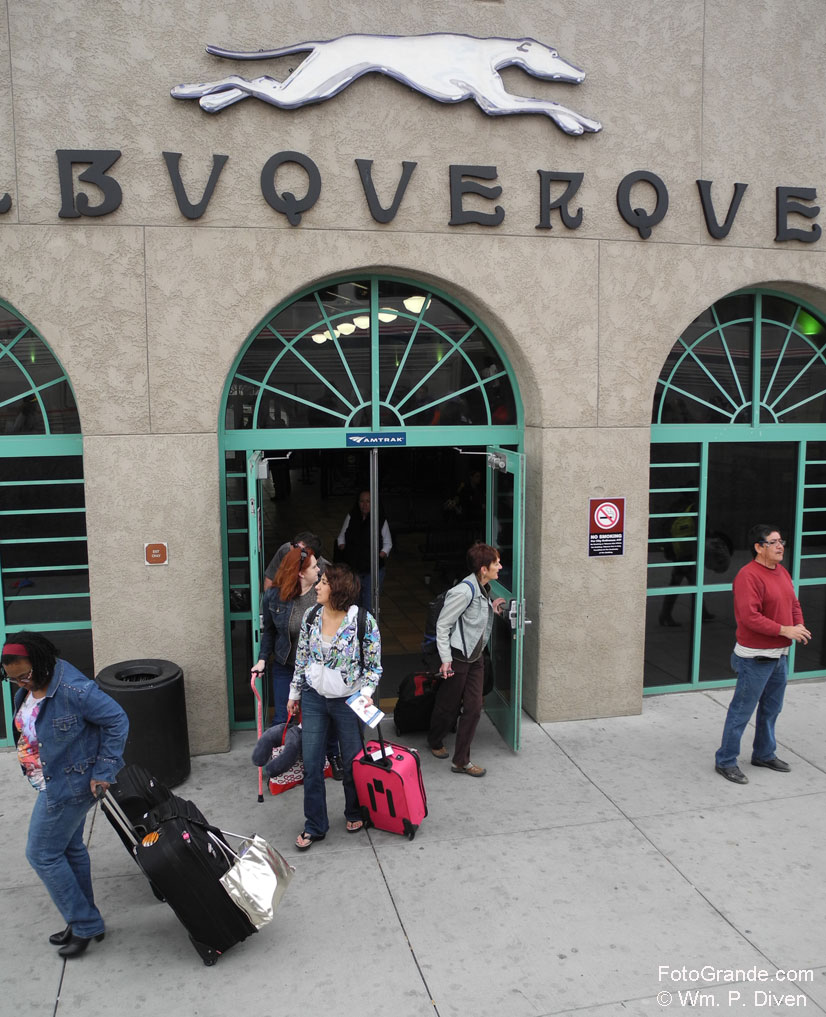
Amtrak passengers head for their train from Albuquerque’s Greyhound (big dog) and Amtrak (tiny sign) station. © William P. Diven (Click to enlarge)
Amtrak regrouped quickly and moved into the last remaining structure from the Alvarado Hotel and Harvey House complex that fell to the wrecker’s ball in 1970. That surviving building, a small box fronting on First Street SW, at least held the distinction of being the warehouse for curios the Harvey company peddled to tourists passing through Albuquerque or taking off into the backcountry on Harvey’s Indian Detours.
To condense a much longer story, Albuquerque eventually convinced Greyhound to give up its terminal across the street in favor of the new building mimicking the Spanish Mission-style train station built against the tracks. It took awhile to maneuver Amtrak into what is essentially a bus station, but so it goes.
For now, at least, Amtrak calls twice a day with Train No. 4, the Los Angeles-Chicago Southwest Chief arriving a little before noon, and its westbound counterpart, No. 3, arriving in late afternoon. Or quite-late afternoon on a recent Saturday as we sat in the waiting room flashing our tickets for the security guard whose job seemed mostly to be keeping street people from using the restrooms or coming inside to warm up. Amtrak.com showed No. 3 to be a little late out of Raton, but with a schedule padded by nearly 30 minutes between Lamy and Albuquerque, it should arrive close to on time. (See related post on Amtrak possibly bypassing Albuquerque.)
It’s an unwritten rule of railroads that late trains get later, and we failed to factor a Rail Runner Express commuter train from Santa Fe into the equation. Regular checks of Amtrak.com showed No. 3’s arrival slipping by a few more minutes every time I looked. From Lamy the Chief got only as far as Control Point Madrid, where the Rail Runner track from Santa Fe joins the Chicago-LA line, before the delays piled up. With Rail Runner first in line, No. 3 crawled along under caution signals and waited as the commuter train made five station stops. When Rail Runner passengers hit the Albuquerque platform, the Chief’s headlight glimmered in the distance near Menaul Boulevard.
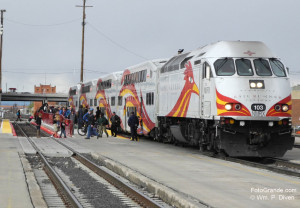
Rail Runner passengers disembark as Amtrak waits farther up the track. © William P. Diven. (Click to enlarge)
Still, Amtrak can make up time in Albuquerque where the Chief takes on fuel, changes the operating crew but not the service staff, undergoes its 1,000-mile inspection and gives passengers and smokers time to stretch their legs and lungs and maybe pick up a burrito, jewelry or souvenir shirts and the like from trackside vendors. At the old station vendors mostly were Native American women selling turquoise-and-silver jewelry arrayed across blankets spread on the ground, a tradition dating to the early days of Fred Harvey’s relationship with the Santa Fe Railway. Now it’s a few local entrepreneurs you might see at a street festival or flea market. This was a cold day in the last week of winter, however, and a blustery north wind discouraged lingering on the platform. With everyone in a hurry, the scheduled 50-minute station stop took 36 minutes including a delay for late passengers. After arriving about an hour and 10 minutes late, we were now only 54 minutes off the advertised.
Once a train starts moving, all is forgiven. There’s still some clickety-clack crossing switches or on older rail where bolts and plates tie together 40-foot links of steel. Otherwise it’s mostly a gentle roll and occasional jolt on ribbons of welded rail stretching for miles. You are now free to stretch your legs out, walk the train on the upper level of the Superliner cars, adjourn to the Sightseer Lounge with picture windows above and small cafe below or just watch the scenery parade by. You can enjoy that second beer knowing there’s a safety-trained designated driver up front.

Santa Fe’s combined Super Chief and El Capitan rolls into Albuquerque in 1968. The El Pasoan is on the right waiting for its southward departure. © William P. Diven. (Click to enlarge)
The Santa Fe ran a first-class passenger operation, and Amtrak has done what it could to uphold those values since taking over in 1971. The route, now almost all on the BNSF Railway, benefits from being mostly double-tracked for high-speed freight service where a higher-speed passenger train can weave around cargo trains with ease. There’s more padding in the schedule at the end of the run, so on time into Los Angeles looked feasible.
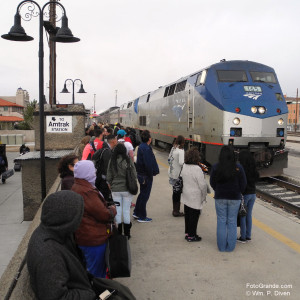
The late-arriving Southwest Chief rumbles into Albuquerque as passengers huddle against the cold wind. © William P. Diven. (Click to enlarge)
This line can have its troubles from washouts to crashing freight trains blocking the tracks, but not like the upper Midwest where blizzards and heavy freight traffic all but knocked out the Chicago-Seattle Empire Building this winter. The Builder took a hit yesterday, too, when a landslide blocked the line along the coast just north of Seattle. Winter also beat up passenger services in the Northeast this year, as have hurricanes over the years along the Atlantic and Gulf Coast. Amtrak’s Sunset Limited once ran from Los Angeles to Jacksonville, Fla., but still terminates in New Orleans despite track wrecked by hurricane Katrina in 2005 being back in service.
It’s best to skip a long lament on how meals on Amtrak are not what they used to be when some trains offered regional menus allowing chefs to shop locally and then work their magic. The Creole salmon we enjoyed after leaving Seattle on the Empire Builder remains with the best meals of our travels ranking with a plate of grilled salmon, halibut, swordfish and prawns at the Schooner Restaurant in Tofino on the desolate west coast of Vancouver Island. Dinner and breakfast on the train were fine if a little plain. For that blame efficiencies in the kitchen and diner wrought as Amtrak, a semi-public corporation, tries to appease critics in Congress who would just as soon shut down the national rail passenger system.
Some important things, however, have not changed. Unless you are a group of four, you will join strangers for meals. Some are more chatty, interesting or slightly deranged than others, but few are boring. (Pretend to be a Nobel Prize winner if you think you can pull it off. You’ll never see these people again, probably.) The same applies to the lounge car. Amtrak blessedly did away with on-board movies, so the lounge is a good place for peaceful sightseeing and casual conversation. It being spring break, a lot of the college kids traveling to LA with us plugged into their earbuds adding to the calm (or maybe they we just tuckered out from partying from Chicago).
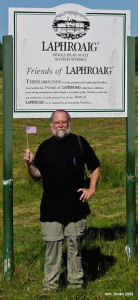
Your author on a pilgrimage to the Laphroaig distillery, Isle of Islay, Scotland. © Katherine Clarke. (Click to enlarge)
I’ve ridden Amtrak enough over the years to be fond of settling into a lounge seat after dinner to enjoy a Scotch or two while jotting in my journal and striking up whatever conversation comes along. This trip would be no different, I thought. On the lower level of the lounge I lined up–only five at a time in the snack bar, the attendant barked–knowing Amtrak stocks Dewar’s, not my Scotch of choice (that would be Laphroaig single malt) but a perfectly fine blended whisky for a shaggy guy passing as a sophisticated traveler. The attendant riffled through his ravaged stock now more than 24 hours out of Chicago and said sorry, pal, nothing but vodka and Jim Beam left. So I scanned the menu on the wall and picked Heineken as a substitute. Oops, completely out of beer, he said with a sweeping gesture toward a naked cooler behind me. It’s spring break, don’t you know?
Deciding all was lost, I said thanks but never mind. Only then did he volunteer I might find Scotch if I tracked down the steward in the diner, which I did as the staff was closing up. Pauline the steward expressed pessimism for my quest but said she’d look. Pulling a tray from a cabinet, she rooted around finally producing the sole surviving miniature bottle of Dewar’s on the train. Things had been pretty crazy on this run, she allowed. I told her she’d just saved my life, an exaggeration, of course, but she had rescued an important component of my travel experience. So, with plastic cup and a little ice, Dewar’s and I repaired to a lounge seat where my journal reflects a few unkind comments about Amtrak’s planning for spring break.
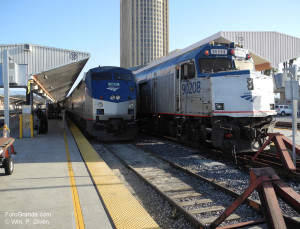
Amtrak’s Southwest Chief rests on arrival in Los Angeles. On the right a commuter train waits to shove out. The Los Angles County jail rises in the background. © William P. Diven (Click to enlarge)
We did arrive in LA on time and took advantage of the first-class Metropolitan Lounge at Los Angeles Union Passenger Terminal while waiting for our Pacific Surfliner train to San Diego. At least we’d been warned that train only ran to Irvine this Sunday because of track work, so 60 minutes of rail comfort led to 90 minutes knees-to-knees wedged against a small table on a cramped bus, pretty much what we experienced on the flight that returned us to Albuquerque a week later.
From the bus we could see the tracks for much of the way along the ocean, and Amtrak did deliver us to downtown San Diego and the classic Santa Fe Railway station still in use there. San Diego’s trolley system and Amtrak and Coaster trains all use the station making it a lively place during the work week and creating a small bustle even on a Sunday afternoon reminiscent of the days when America was glad to travel by train. We’ll be riding Amtrak again this summer but getting on in Los Angeles where the lounge will be fully stocked. Having learned my lesson I’ll pack along a little Laphroaig anyway since sleeping-car passengers are allowed to bring their own.

